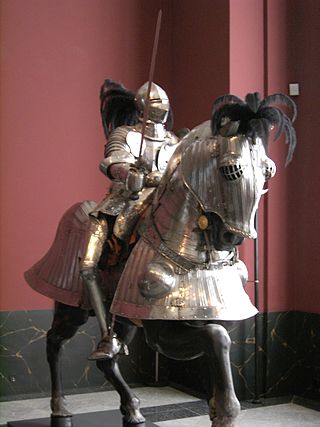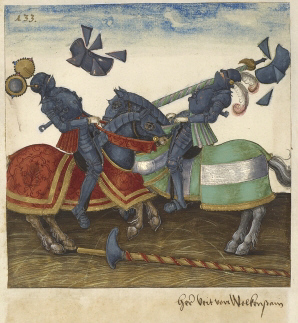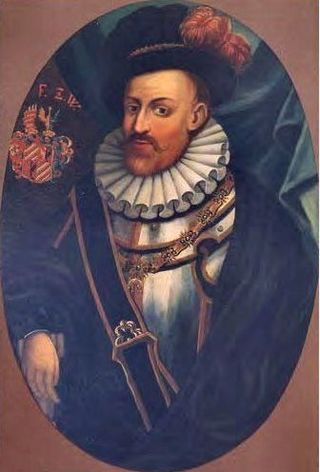| fol. | Image | Tournament and activity | Image description | Ref. |
|---|
| 1 |  | Tournament 1 Rennen | Scharfrennen (Joust of war with "flying" shields) against Christoph Schenk von Limburg [ de ]. See fol. 145 | pp. 54–55 |
| 2 |  | Tournament 1 Stechen | Welsches Gestech (Italian joust of peace) against Count Engelbert II of Nassau (1451-1504), Lord of Breda, and a Burgundian diplomat. Freydal's helmet has a sun crest and his horse bears a unicorn horn on its shaffron | p. 56 |
| 3 |  | Tournament 1 Foot joust | Combat with glaives with an opponent noted as "Leonhart Rueshaimer" | p. 57 |
| 4 |  | Tournament 1 Mummery | Masquerade where the dancers include Wilhelm von Roggendorf (1481-1541), a high-ranking diplomat and Habsburg military commander, and three other named courtiers | pp. 58–59 |
| 5 |  | Tournament 2 Rennen | Geschifttartschen-Rennen (Joust of war with flying and exploding shields) with Anton von Yfan. Von Yfan here wears a helmet with donkey ears. | pp. 60–61 |
| 6 |  | Tournament 2 Rennen | Krönlrennen (Mixed joust of war and joust of peace) with Count Felix von Werdenberg-Sargans (d.1530), a military commander and courtier. Maximilian's aunt, Catherine of Austria, was his grandmother. | p. 62 |
| 7 |  | Tournament 2 Foot joust | Combat with halberds with Leonhard Vetter (in the red surcoat), a member of the aristocratic Vötter von der Lillie family, who had estates in Moravia and Styria. | p. 63 |
| 8 |  | Tournament 2 Mummery | The revellers wear Italian costumes. Those present include Erhard von Polheim und Liebnitz, Wilhelm Scurrff Jörg von Harras and Maximillian's seneschal and lifelong friend Melchior von Massmünster. | pp. 64–65 |
| 9 |  | Tournament 3 Rennen | Anzogenrennen (Joust of war with fixed shields) with Sigmund von Welsperg (d.1503), Maximilian's chamberlain, who is unhorsed. | pp. 66–67 |
| 10 |  | Tournament 3 Stechen | Deutsches Gestech (German joust of peace) with Count Eitel-Frederick II von Hohenzollern (1452-1512), who was one of Maximilian's closest friends. He was also one of the band of nobles who helped Maximilian escape from Bruges during the Flemish Revolt of 1487-1492. Here, he has a ram's horns crest. | p. 68 |
| 11 |  | Tournament 3 Foot joust | Combat with swords and bucklers with Mathias Vetter. A buckler was a small fencing shield | p. 69 |
| 12 |  | Tournament 3 Mummery | The dancers are dressed in Spanish costumes. They include Siegmund von Dietrichstein (1480-1533), a close associate of Maximilian. | p. 70 |
| 13 | 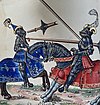 | Tournament 4 Rennen | Feldrenen with lances (Joust of war in reinforced armour) against an unnamed knight (on the left), who bears the emblems of the Order of the Golden Fleece. | pp. 72–73 |
| 14 |  | Tournament 4 Stechen | Welsches Gestech (Italian joust of peace, with tilt) against "Der Teufl". This is a member of the Teufel family, and his helmet is in the shape of a monster with a sharp beak. | p. 74 |
| 15 |  | Tournament 4 Foot joust | Combat with halberds with Count Engelbert II of Nassau | p. 75 |
| 16 |  | Tournament 4 Mummery | The dancers include the Austrian aristocrats Wilhelm von Wolfenreut (d.1520) and Heinrich Elacher. The latter was brought up with Maximilian when he was in his pre-teens. | pp. 76–77 |
| 17 |  | Tournament 5 Rennen | Anzogenrennen (Joust of war with fixed shields) against Count Wolfgang I von Fürstenberg (1465-1509), who is unhorsed. Fürstenberg held a number of important positions in Maximilian's court. | pp. 78–79 |
| 18 |  | Tournament 5 Stechen | Welsches Gestech (Italian joust of peace, with tilt) against Lord Jan III van Bergen op Zoom (1452-1531), who held a number of important posts in Namur during both Maximilian's reign and that of Charles V | p. 80 |
| 19 |  | Tournament 5 Foot joust | Combat with swords, throwing stars and shields with Count Albert von Hohenzollern, brother of Eitel-Frederick II (see folio 10 above). Albert died taking part in Maximilian's attack on Utrecht in 1483 | p. 81 |
| 20 |  | Tournament 5 Mummery | The dancers wear the colours chosen for Freydal by 3 princesses at the beginning of the draft text narrative. The dancers include Jörg von Liechtenstein-Carneid, commander of the army of the Swabian League and Volkart von Auersperg. Two members of the House of Auersperg bore this name at the time. One of them was brought up with Maximilian in the 1460s. | p. 82-83, 159 |
| 21 |  | Tournament 6 Rennen | Bundrennen (Joust of war with "flying" shields without bevors) against Count Hoyer VI von Mansfeld (1482-1540), an imperial councillor, who has a helmet crest of stag antlers and flowers. | pp. 84–85 |
| 22 |  | Tournament 6 Stechen | Deutsches Gestech (German joust of peace) against Hans Teschitz, a Croatian courtier who was Maximilian's equerry. | p. 86 |
| 23 |  | Tournament 6 Foot joust | Combat with awl pikes (see fol. 147) against Wolfgang von Polheim. | p. 87 |
| 24 |  | Tournament 6 Mummery | The revellers taking part in a circle dance, include members of the Losenstein, Schiffer and Tschermembl families. Mathias von Liechtenstein, who was brought up with Maximilian, also features in the scene. | pp. 88–90 |
| 25 |  | Tournament 7 Rennen | Bundrennen (Joust of war with "flying" shields without bevors) against Philipp von Rechberg (see fol. 200) who is the knight lying on the right with donkey ears as a helmet crest. This is one of the few paintings of a joust in the tournament book with a background scene featuring other characters beside the two jousting knights. | pp. 90–91 |
| 26 |  | Tournament 7 Stechen | Welsches Gestech (Italian joust of peace) against Michel van Bergen (in red) whose helmet crest is a fig sign, an obscene gesture which equates, in modern terms, to giving the finger. Michel van Bergen was killed during a siege of Huy near Liège in 1482. His brother featured in fol.18. | p. 92 |
| 27 |  | Tournament 7 Foot joust | Combat with glaives against the Burgundian aristocrat, Philip of Cleves, Lord of Ravenstein (1456-1528). Although for most of his life he supported the Habsburgs, he rebelled against Maximilian in the late 1480s. | p. 93 |
| 28 |  | Tournament 7 Mummery | The dancers at this masquerade are dressed as hunters and include members of the Lowenstein, Oeder, Zelking, and Painer noble families. | pp. 94–95 |
| 29 |  | Tournament 8 Rennen | Geschifttartschen-Rennen (Joust of war with "flying" and "exploding" shields) against Sigmund von Welsperg (see fol. 9) | pp. 96–97 |
| 30 |  | Tournament 8 Stechen | Welsches Gestech (Italian joust of peace) against Friedrich von Horn. Freydal wears a helmet crest of antlers. | p. 98 |
| 31 |  | Tournament 8 Foot joust | Combat with long swords against Wilhelm Knöringen, of a Swabian noble family. | p. 99 |
| 32 |  | Tournament 8 Mummery | The dancers include a member of the Trautmansdorff noble family. | pp. 100–101 |
| 33 |  | Tournament 9 Rennen | Scharfrennen (Joust of war with "flying" shields) with Philipp von Rechberg (see fol.200) | pp. 102–103 |
| 34 |  | Tournament 9 Stechen | Deutsches Gestech (German joust of war) against Wolfgang von Polheim | p. 104 |
| 35 |  | Tournament 9 Foot joust | Combat with flails against Georg von Montfort (see fol.81). | p. 105 |
| 36 |  | Tournament 9 Mummery | This painting depicts a moresca , a dance where the male dancers attempt to impress the watching ladies with wild jumps and twists. | pp. 106–107 |
| 37 |  | Tournament 10 Rennen | Anzogenrennen (Joust of war with fixed shields) with Christopher I, Margrave of Baden (1453 - 1527), who is the rider on the ground obscured by his horse. | pp. 108–109 |
| 38 |  | Tournament 10 Stechen | Welsches Gestech (Italian joust of peace) against Franciscus de Montibus, ambassador of the king of Naples, who has been unhorsed. Franciscus de Montibus is recorded as jousting with Maximilian several times in March 1498. | p. 110 |
| 39 |  | Tournament 10 Foot joust | Combat with maces (war hammers) and targes (small shields) against Claude de Vaudry (died 1515), Burgundian nobleman who had served Charles the Bold. There is a record of Maximilian jousting against Claude de Vaudry in 1495 | p. 111 |
| 40 |  | Tournament 10 Mummery | A masquerade in which the named participants includes a Jacob van Castel. Someone of that name was a courtier in the time of Maximilian's father, Frederick III. He was part of the entourage that greeted Maximilian's mother, Eleanor of Portugal, when she first arrived from her homeland. | pp. 112–113 |
| 41 |  | Tournament 11 Rennen | Geschiftscheiben-Rennen (Joust of war with "exploding" shields) against an unnamed opponent. This is the only image in the tournament book of this type of Rennen | pp. 114–115 |
| 42 |  | Tournament 11 Stechen | Deutsches Gestech (German joust of war) against Philipp von Rechberg (see fol.200). | p. 116 |
| 43 |  | Tournament 11 Foot joust | Combat with halberds against Anton von Yfan | p. 117 |
| 44 |  | Tournament 11 Mummery | This masquerade included Anton vom Ross (Antonio Cavalli) who was a mineowner and the financial administrator of the Tyrol. The limited relaxation of strict court etiquette during masquerades allowed for an element of greater interaction amongst courtiers of different social standing. | pp. 118–119 |
| 45 |  | Tournament 12 Rennen | Geschifttartschen-Rennen (Joust of war with "flying" and "exploding" shields) against Anton von Yfan. Maximilian is recorded jousting with von Yfan at Innsbruck in 1498. | pp. 120–121 |
| 46 |  | Tournament 12 Stechen | Welsches Gestech (Italian joust of peace) against Hanns von Reichenberg (died 1522). | p. 122 |
| 47 |  | Tournament 12 Foot joust | Combat with pikes against a member of the Turisan family from Tyrol-Trentino | p. 123 |
| 48 |  | Tournament 12 Mummery | The colours of the participants in this painting are the colours of the Order of the Golden Fleece. The dancers are all members of aristocratic families from Austria, Alsace and Slovenia. | pp. 124–125 |
| 49 |  | Tournament 13 Stechen | Deutsches Gestech (German joust of peace) with Veit von Wolkenstein (see fol.133). Freydal (on the left) wears the headress of a lady of the Burgundian court, in reference to Maximilian's wife Mary of Burgundy. | pp. 126–127 |
| 50 |  | Tournament 13 Rennen | Anzogenrennen (Joust of war with fixed shields) against Sigmund von Welsperg (see fol.9) | p. 128 |
| 51 |  | Tournament 13 Foot joust | Combat with awl pikes against Baron Georg of Castelbarco and Castelcorno, who was a commander in Maximilian's war in Hungary in the 1490s. | p. 129 |
| 52 |  | Tournament 13 Mummery | This is an unusual mummery depiction in that instead of a dance, the masquerade is a prize-giving ceremony out of doors. The judges are in the guise of a king and queen. Participants include Friedrich von Stubenberg, another childhood friend of Maximilian's | pp. 130–131 |
| 53 | 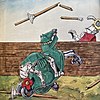 | Tournament 14 Stechen | Welsches Gestech (Italian joust of peace) against Hanns Reinwald, who is in the foreground in green. | pp. 132–133 |
| 54 |  | Tournament 14 Rennen | Anzogenrennen (Joust of war with fixed shields) against Christoph von Lamberg. A nobleman from a long-standing Slovenian family, von Lamberg loyally served both Maximilian and his father. | p. 134 |
| 55 |  | Tournament 14 Foot joust | Combat with pikes against Count Melchior von Mühlingen and Barby (1493-1519). He served as Rector of the University of Wittenberg. | p. 135 |
| 56 |  | Tournament 14 Mummery | The participants in this masquerade include members of the aristocratic families of Altenhauser from Styria, Goldaker from Carinthia and Scherffenberg from Carniola. | pp. 136–137 |
| 57 |  | Tournament 15 Stechen | Deutsches Gestech (German joust of peace) against Count Friedrich von Öttingen believed to be the same person of that name who became bishop of Passau in 1485 | pp. 138–139 |
| 58 |  | Tournament 15 Rennen | Anzogenrennen (Joust of war with fixed shields) against Wolfgang von Fürstenberg (see fol.17) | p. 140 |
| 59 |  | Tournament 15 Foot joust | Combat with long swords against a member of the Swabian Erolzheim family, several of whom served the Habsburgs in the late 15th century. | p. 141 |
| 60 |  | Tournament 15 Mummery | The dancers include Wolfgang von Dietrichstein, cousin of the Dietrichstein in fol.12. | pp. 142–143 |
| 61 |  | Tournament 16 Stechen | Deutsches Gestech (German joust of peace) against Balthasar von Roggendorf in yellow and gold on the left. He was another of the noblemen brought up with Maximilian and was the uncle of Wilhelm von Roggendorf in fol.4. | pp. 144–145 |
| 62 |  | Tournament 16 Rennen | Bundrennen (Joust of war with "flying" shields and without bevors) against Wolfgang von Polheim. Von Polheim is in the right. | p. 146 |
| 63 |  | Tournament 16 Foot joust | Combat with maces and targes against Maximilian's childhood friend Melchior von Massmünster (see fol.8) | p. 147 |
| 64 |  | Tournament 16 Mummery | In this dance the male revellers wear women's clothes. Cross-dressing in this way in late medieval masquerades has been recorded multiple times. The dancers are all members of the high nobility: the Windisch-Graetz, Liechtenstein and Dietrichstein families. | pp. 145–146 |






































































































































































































































































